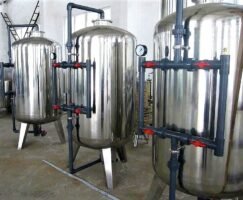hydrochar adsorption
Hydrochar Adsorption: A Promising Technology for Water Treatment
Introduction
In recent years, water pollution has become a significant environmental concern due to the discharge of various pollutants from industrial, agricultural, and domestic sources. One of the major challenges faced by researchers and policymakers is finding effective and sustainable technologies to remove contaminants from water. Adsorption is a popular method for water treatment, as it is cost-effective, easy to implement, and can remove a wide range of pollutants. One promising material for adsorption is hydrochar, a carbon-rich material produced through the hydrothermal carbonization of biomass. In this article, we will explore the potential of hydrochar adsorption for water treatment and discuss its advantages, limitations, and future prospects.
What is hydrochar adsorption?
Hydrochar is a carbon-rich material produced by subjecting biomass to high temperature and pressure in the presence of water. The hydrothermal carbonization process mimics the natural coal formation process but occurs at lower temperatures and shorter timescales. The resulting hydrochar has a porous structure with a high surface area, making it an excellent adsorbent for a wide range of contaminants in water.
Adsorption is a process in which a solute is removed from a liquid or gas by accumulating on the surface of a solid material. Hydrochar adsorption involves the transfer of contaminants from water to the surface of the hydrochar material, where they are trapped and immobilized. The high surface area and porous structure of hydrochar enhance its adsorption capacity, making it an effective and efficient material for water treatment.
Advantages of hydrochar adsorption
1. High adsorption capacity: Hydrochar has a high surface area and a porous structure, which allows it to adsorb a large amount of contaminants from water.
2. Versatility: Hydrochar can be produced from a wide range of biomass feedstocks, such as agricultural residues, food waste, and sewage sludge, making it a versatile material for adsorption.
3. Cost-effective: The production of hydrochar is relatively inexpensive compared to other adsorbent materials, making it a cost-effective option for water treatment.
4. Sustainability: Hydrochar is a renewable and sustainable material that can be produced from biomass waste streams, reducing the environmental impact of water treatment processes.
5. Regenerability: Hydrochar can be regenerated and reused multiple times, extending its lifespan and reducing the overall cost of water treatment.
Applications of hydrochar adsorption
Hydrochar adsorption has been widely studied for the removal of various contaminants from water, including heavy metals, organic pollutants, and emerging contaminants. Some common applications of hydrochar adsorption include:
1. Removal of heavy metals: Hydrochar has shown promising results in the adsorption of heavy metals such as lead, cadmium, and mercury from water. The high surface area and porous structure of hydrochar allow it to effectively trap and immobilize heavy metal ions, reducing their concentration in water.
2. Removal of organic pollutants: Hydrochar has also been used to remove organic pollutants such as dyes, pesticides, and pharmaceuticals from water. The adsorption capacity of hydrochar makes it an effective material for removing organic contaminants, improving water quality and safety.
3. Removal of emerging contaminants: Emerging contaminants, such as microplastics and per- and polyfluoroalkyl substances (PFAS), pose a growing threat to water resources. Hydrochar adsorption has shown promise in removing these contaminants from water, contributing to the protection of aquatic ecosystems and human health.
Challenges and limitations of hydrochar adsorption
Despite its many advantages, hydrochar adsorption also faces some challenges and limitations that need to be addressed for its widespread application in water treatment. Some of the main challenges include:
1. Competition with other adsorbents: Hydrochar must compete with other adsorbent materials, such as activated carbon and biochar, which have been more extensively studied and commercialized for water treatment.
2. Influence of water matrix: The composition and properties of the water matrix can impact the adsorption performance of hydrochar, affecting its effectiveness in removing contaminants.
3. Regeneration and reuse: While hydrochar can be regenerated and reused multiple times, the regeneration process can be energy-intensive and costly, limiting its practical application in large-scale water treatment.
4. Scale-up and commercialization: The scale-up and commercialization of hydrochar adsorption technologies require significant investment and infrastructure, posing challenges for researchers and industry stakeholders.
Future prospects of hydrochar adsorption
Despite these challenges, hydrochar adsorption holds great potential for addressing the water pollution crisis and advancing sustainable water treatment technologies. Future research and development efforts should focus on:
1. Optimization of hydrochar production: Improving the production process of hydrochar to enhance its adsorption capacity, durability, and cost-effectiveness.
2. Development of multifunctional materials: Combining hydrochar with other materials to create multifunctional adsorbents with enhanced adsorption capabilities for removing a wide range of contaminants from water.
3. Application in hybrid treatment systems: Integrating hydrochar adsorption with other water treatment technologies, such as membrane filtration and electrooxidation, to enhance overall water treatment efficiency and reliability.
4. Evaluation of environmental impact: Assessing the environmental impact of hydrochar adsorption technologies in terms of energy consumption, emissions, and waste generation to ensure their sustainability and compatibility with circular economy principles.
Conclusion
Hydrochar adsorption is a promising technology for water treatment, offering high adsorption capacity, versatility, cost-effectiveness, and sustainability. Despite facing challenges and limitations, such as competition with other adsorbents and the influence of water matrix, hydrochar adsorption has the potential to address the water pollution crisis and advance sustainable water treatment technologies. Future research and development efforts should focus on optimizing hydrochar production, developing multifunctional materials, applying hybrid treatment systems, and evaluating the environmental impact of hydrochar adsorption technologies. By addressing these challenges and leveraging the advantages of hydrochar adsorption, we can unlock its full potential and contribute to a cleaner and healthier environment for future generations.

